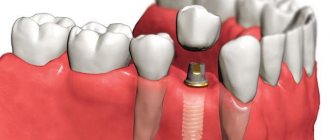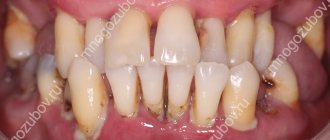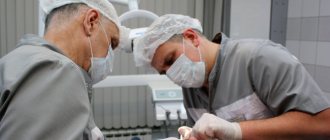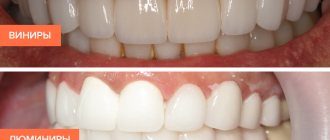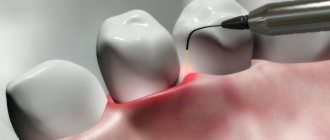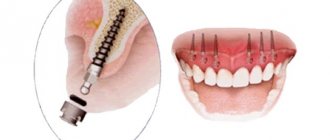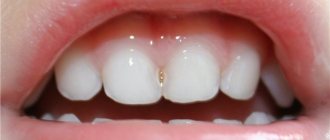And one in the field is a warrior
Do not rush to agree to have your teeth removed - first try all the possibilities to save them. And there are many of these, from dental restoration to the installation of pins, inlays and other devices that can grow a tooth literally from nothing - even from one surviving root.
But if a loss does occur, do not delay with prosthetics.
It is optimal to contact an implantologist after removal in 2–3 months. But sometimes the results will be better with one-stage implantation, which is both faster and cheaper. True, it is not always possible.
Article on the topic
Spasms, insomnia, migraine. How bad teeth destroy the body
Why rush in such a hurry, especially if the missing tooth is not particularly visible when you smile? And then, that due to a long-term lack of even just one tooth, all the others will shift. This causes all sorts of problems. Among them:
- headaches (due to dysfunction of the temporomandibular joint);
- excess weight and gastrointestinal diseases (due to impaired chewing function and the development of high acidity);
- premature aging (changes in facial oval, tissue ptosis, appearance of deep wrinkles and nasolabial folds). All due to atrophy of the jaw bone tissue;
- apnea syndrome (changes in the functioning of the maxillofacial system lead to cessation of breathing during sleep, which can lead to heart attacks and strokes);
- speech impairment and psychological discomfort.
Treat without a drill. What procedures have dentists refused? More details
What is the risk of implant failure in the smile area? What other complications could there be?
Small-diameter implants are usually installed in the smile area, which are placed below the level of the bone, which allows you to achieve good aesthetics in the gum area and avoid plastic surgery. As for the implant company, I would not trust unverified and unknown companies, since at one time there were a lot of them on the dental market, but many have closed, so if any part breaks, for example, a crown, it will be very difficult to find a replacement.
In addition, some manufacturers make significant errors in the manufacture of their products, which can also result in rejection. I myself prefer to use the German system, which has been producing implants for more than 25 years. However, no matter what system you choose, a lot depends on the specialist. If the doctor is not sufficiently qualified, the risk of rejection increases greatly.
We invite you to familiarize yourself with the Implant a year after tooth extraction
Photos of patients before and after implantation at the Research Center. Works by Dakhkilgov M.U.
In fact, implants can be rejected for various reasons: due to non-compliance with doctor’s recommendations, poor hygiene, and so on. Different doctors and implant manufacturers have their own indicator. In our clinic, implants take root in 99% of cases. As for complications, an incorrectly installed implant leads to exposure of the gingival margin, and then part of it will be visible from under the gum.
Such a serious mistake will lead to numerous problems and may even cause rejection. The same consequences after dental implantation can be caused by installing an implant that is too large. Of course, this complication is of particular importance when implanting anterior teeth, where aesthetics always comes first.
In addition, a lot depends on the abutment. If we are talking about the frontal group of teeth, then we use individual white zirconium abutments, which are made taking into account the volume of the mucous membrane and the shape of the patient’s teeth and do not show through the gums.
A little history
People made the first attempts at dental prosthetics in ancient times. Even before our era, there were attempts to replace lost teeth with animal teeth.
Over time, prosthetics became more advanced - they began to be made of gold, lead, and ivory. However, many dentists acted the old fashioned way; in medieval Europe, the teeth of soldiers who died on the battlefield were often used as material for making dentures. Dentures in those days were not very reliable - they were easy to lose while eating or talking. By the way, according to one version, the fashion for fans was due to this particular feature of false teeth - beauties needed something to cover their mouths if the denture suddenly fell out during a social event.
The revolution in prosthetics occurred thanks to Pierre Fauchard , the personal dentist of the French King Louis XV. It is to him that humanity owes the appearance of the bridge prosthesis.
And the first dental implant was placed in 1965 by Professor Ingvar Brånemark , a scientist and dentist from Sweden.
Article on the topic
Basal implantation. How are teeth restored today?
And now smile!
However, if you decide to replace a lost tooth with an artificial one in a couple of days in order to meet your anniversary, be prepared for disappointment. After all, this is not always possible. The process can be significantly delayed, and not through the doctor’s fault.
First, let’s talk about how exactly implantation occurs.
Stage 1 – treatment planning. The doctor necessarily conducts diagnostics (identifies caries and other diseases of the oral cavity) and plans implantation based on CT (3D imaging). He also gives directions for blood tests (general and clinical) to make sure that the patient does not have blood diseases or other serious conditions. If they are detected, you will need to go to a specialist to determine whether implantation can be performed or whether it is better to postpone it until a stable remission occurs.
Stage 2 – preparation. If diseases of the teeth and gums are detected, they will first have to be treated, because any inflammation in the oral cavity will lead to the implant being simply rejected by the body. If everything is fine, the doctor will carry out professional cleaning (to rid the teeth of hard plaque, under which bacteria can remain), and that’s all.
Stage 3 – implantation itself – implantation of a titanium root into the jaw. The process itself usually takes less than an hour. A hole is formed specifically according to the size of the future root in the bone tissue of the jaw. The sutures are removed after 7–10 days, and a little later the gum former is installed. A few months later, after the impressions are taken, first temporary and then permanent crowns are placed. But there is also a one-stage implantation, in which a prototype of the future tooth is installed in the patient immediately on the day of implantation. And after a couple of months, the temporary crowns are replaced with permanent ones. Accordingly, in this case you will not have to walk without teeth for a day.
Prosthetics. Dentist - about crowns and their installation Read more
How to walk with front tooth implantation?
https://www.youtube.com/watch?v=ytcopyrightru
In the anterior region, bone loss, unfortunately, occurs quite often. Especially in cases where the patient has been missing a tooth for a long time, or was lost due to injury. However, even in this case, as a rule, implantation of the lower anterior teeth, as well as the upper ones, is carried out simultaneously with bone grafting or sinus lifting, if we are talking about prosthetics of the upper anterior teeth. This saves the patient time and effort, and also preserves the shape of the gums, which is important for obtaining a good aesthetic result.
You should care for your anterior implants the same way you would care for your teeth. You definitely need to visit a hygienist at least once every six months, come for an examination once a year, and, of course, follow the dentist’s recommendations: at first, do not put too much stress on the implant and take medications. After the main stages of dental implantation have been completed - the implant has taken root and a permanent crown has been installed, it can be used as if it were your own tooth. As for service life, implants are forever.
We don't believe myths
Many people are afraid to get implants because of common misconceptions:
Myth No. 1. Few people can get implants due to a lot of contraindications.
In fact, the only absolute contraindications are blood diseases and cancer. But if they are in stable remission, then implantation can be carried out even in the presence of these ailments. All other features are considered privately. And under favorable conditions, teeth are implanted even in very elderly people, patients with pacemakers, people after a heart attack and stroke, heavy smokers, patients with diabetes (provided there are normal metabolic processes in the bones and the absence of tissue regeneration disorders). Of course, in severe cases of illness with frequent exacerbations, it is better to refuse implantation.
Article on the topic
Crowns in one visit. How are new teeth printed?
Myth No. 2. The implant is uncomfortable and rubs until it bleeds.
In fact, maybe this was once the case, but today it is impossible. Initially, the crown is created virtually. The computer models the position of the prosthesis in the bone tissue, and a navigation template is printed on a 3D printer to help the doctor accurately install the implant in a given direction. So everything is adjusted in advance.
Myth No. 3. You can’t eat whatever you want with implants.
In fact, for some time, yes, but after the crown is installed, you can eat any food. It’s just like with your own teeth.
Advantages and disadvantages
The main advantages of such prosthetics:
- a worthy alternative to healthy teeth in terms of functionality - you can safely chew and bite food, brush and carry out any actions that are possible with your own teeth;
- durability;
- a beautiful smile, the implant cannot be distinguished from a natural tooth by external signs;
- the ability to replace one or all elements of the jaw row;
- there is no need to grind and load adjacent healthy units;
- There is no risk of falling out while talking or chewing food.
The disadvantages of implantation include:
- the appearance of inflammatory processes and the possibility of implant rejection (today this is a rather rare occurrence);
- swelling and pain during the rehabilitation period;
- high cost of systems and specialist work;
- difficulties arise in the process of finding a decent doctor;
- long treatment period;
- a large number of contraindications.
The video provides additional information on the topic of the article.
Choosing a clinic
To choose a doctor and clinic and not regret it later:
1. Check diplomas and licenses . Only a specialist with a diploma as an implantologist or maxillofacial surgeon has the right to perform implantation.
2. Assess the equipment of the clinic (availability of modern equipment, operating room with sterile conditions). According to standards, the surgical room is sanitized before each operation, and the staff dresses in disposable sterile clothing.
3. Conclude an agreement. Read it carefully before signing; if you don’t understand, please clarify.
“Written in the family”? Dentist - about the main causes of dental diseases Read more
We don't spend too much
Implantation is an expensive proposition. And it cannot cost a penny, since it requires expensive materials and highly skilled labor. But it doesn’t make sense to overpay too much either. In order not to run into low-quality dentures, you should only go to specialized clinics and not trust too low prices. But you also shouldn’t think that only a very expensive implant will last long. What is more important is not the steepness of the implant, but the quality of the material from which this prosthesis is made (usually titanium). The standard market price of the implant itself is from 30 thousand rubles. If a clinic heavily dumps or offers promotions like “3 implants for the price of 2,” avoid it. Also, do not delude yourself when they give a lifetime guarantee for implantation. Most likely, it only means a guarantee for the implant itself, and not for the entire result.
To avoid being scammed for unnecessary procedures, contact only trusted clinics. It is almost impossible to assess the need for a particular examination on your own. For example, often a doctor needs to get the result of a three-dimensional examination, and sometimes a simple panoramic image is enough. Or in some cases it is really necessary to build up bone tissue, and sometimes you can do without it. If in doubt, it is better to get a second opinion - from a doctor in another clinic. By the way, the doctor should warn the patient about all upcoming procedures, and not silently enter the amount into the check for the service.
Degree of bite deformation and dental implantation
Experts distinguish two degrees of occlusion:
- Jaw displacement . With a slight displacement, implantation is possible. Sometimes in such a situation the problem can be corrected through the use of dentures. When severe jaw misalignment is observed, implantation will most likely be denied.
- Incorrect position of teeth . When the roots of adjacent units do not interfere with the installation of the implant, attention is paid to aesthetics. If you cannot achieve the ideal look right away, alignment is required using a braces system. Another option is to remove the interfering units.
To more accurately determine the clinical situation, a preliminary x-ray examination of the oral cavity is performed and impressions of the jaws are taken.
Minor deformations include:
- lack of space in the dentition to install a full crown on an implant;
- tilting or incorrect rotation of some teeth;
- large gaps between teeth.
In case of minor violations, implantation can be performed. However, the patient is made aware of the possible risks. If he is ready to put up with it, the procedure is carried out.
If there is severe malocclusion, titanium roots cannot be installed until the dentition is straightened. For this purpose, preliminary orthodontic treatment is carried out. Otherwise, there is a risk of strengthening and strengthening the deformity, which can even harm the patient. Therefore, an implant surgeon may refuse to perform implantation.
